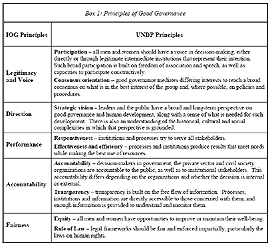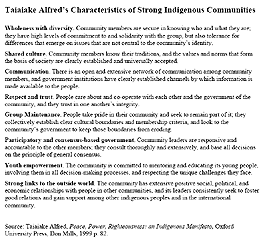Self Governance
 Governance and government are terms that are often confused. THe United Nations Development Program (UNDP) outlined principles of good governance (click on small graphic to the right to read the entire description of these principles). Self governance initatives within First Nations communities follow these principles of good governance well, with a unique perspective and approach - they at least try to, despite the negative influences of colonization that complicates the expression of traditional values and behaviour.
Governance and government are terms that are often confused. THe United Nations Development Program (UNDP) outlined principles of good governance (click on small graphic to the right to read the entire description of these principles). Self governance initatives within First Nations communities follow these principles of good governance well, with a unique perspective and approach - they at least try to, despite the negative influences of colonization that complicates the expression of traditional values and behaviour.
- Legitimacy and Voice - are evident with a strong emphasis on consensus rather than on simple majority rule. However the legacy of leadership elections (imposed by colonization via the Indian Act in Canada) compromise this traditional tendency and often cause divisions within communities due to the competition nature of elections. Taiaiake Alfred perhaps said it best, "Native governments must be made legitimate within their communities.. The only way to accomplish this is by rejecting electoral politics and restructuring Native governments to accommodate traditional decision-making, consultation, and dispute resolution processes". (2. Alfred, T. 1999, p. 136).
- Fairness - respectful equity principles reflect a unique view of the role of women, elders, and youth and their place in society with laws and rules steeped in oral traditions and spiritual teachings rather than written legislation. Again the Indian Act and the influence of colonization has assaulted the social status of aboriginal women and often demonizes aboriginal youth.
- Direction and Leadership - is centered around the common culture, community identity, and consideration of the collective well-being
- Performance - reflects a holistic view of the community's place in nature, a deep love and kinship with the land, and wise stewardship of all the Earth's resources, plants, and creatures.
- Accountability - all actions are tied to the support and development of family, kinship, interconnected community structures. (1. Graham & Wilson, 2004, p.6).
Moving towards the Ideal
 Alfred Taiaiake (1999) presented a clear description of healthy Aboriginal communities who are ready to engage in traditional self government. He describes strong aboriginal commmunities through a variety of traits including the following
Alfred Taiaiake (1999) presented a clear description of healthy Aboriginal communities who are ready to engage in traditional self government. He describes strong aboriginal commmunities through a variety of traits including the following
(click on the image to the left to read the full description.)
★ Wholeness with diversity★ Shared Culture
★ Communication
★ Respect and Trust
★ Group Maintenance
★ Participatory and consensus-based governance
★ Youth empowerment
★ Strong links to the outside world
So, what could Aboriginal self governance in health care look like? Imagine a locally operated health care support system, say a health clinic that was open seven days a week, and offered an interdisciplinary array of health professionals, both traditional and contemporary, who were readily available to a particular Nation. Imagine that this team is dedicated to working together in a wholistic manner, one that supports the unique needs of each individual within the community. Imagine that nutrition counseling was based on traditional foods of that particular Nation. Imagine the local herbs and other medicines from the land were gathered and prepared in traditional ways and were readily available to the community. Imagine a holistic approach was taken to health care, and aboriginal children were encouraged to recognize their own healing gifts, and to share them with the community. Imagine that the essence of self governance in health care was intertwined with all other social activities, such as education, relationship building, community development, and cultural traditions. This is the goal of self governance!
1. Graham, J. & Wilson, J. (2004). Aboriginal Governance in the decade ahead: Towards a new agenda for change. A Framework Paper for the TANAGA Series. Ottawa: Institute on Governance.
2 Taiaiake, A. (1999). Peace, Power, Righteousness: an Indigenous Manifesto. Don Mills, ON: Oxford University Press.
Self Governance Resources
☸ Aboriginal governance in the decade ahead: Towards a new agenda for change
by Graham, J. & Wilson, J. (2004), A Framework Paper for the TANAGA Series. Ottawa, Ontario: Institute on Governance.
☀ Creating the Future: A Planning Handbook for Board Members and Administrators of First Nations Boards 2004. Written by Dr. Larry Thomas for the First Nations Education Steering Committee.
☉ First Nations Governance Projects: Challenge and Innovation. An Overview of Research Results From the Carlton Centre for Community Innovation. Prepared for the First Nations Governance Centre to illlustrate First Nations Governance Pilots Projects: Challenge and Innovation Report.
PPT:
http://www.fngovernance.org/pdf/Carleton_ppt.pdf
☸ Group Apraxia: The Phenomenology of Acculturalism by Aubrey Neal, University of Manitoba. Excellent paper focused on the perpetual cycle of assimilation expectations and the move towards self governance.
☀ Supporting Self Governance in First Nations Education. by June Kaminski (2008), Presentation used within Webcast presented on Supporting Educational Self Governance - Aboriginal Literacy and Pedagogical Considerations. Webcast available at http://firstnationspedagogy.ca/webcast.html . May 28, 2008.
☉Tribal Self Governance
from the USA based Office of the Self-Governance Communication & Education (SGCE). The information on this website is provided to enhance the understanding of Self-Governance, as well as the motivation, reasoning and aspirations behind this historic Tribally driven initiative.
More Resources
☀National Centre for First Nations Governance (NCFNG) An innovative service and research organization offering an important set of nation re-building services to First Nations from the Atlantic to the Pacific. NCFNG provides a bridge between traditional and contemporary governance models. Services are developed and delivered by experienced and educated Aboriginal staff.
☸Negotiating Identity: Aboriginal Women and the Politics of Self-Government by Elizabeth A. Asante (2005). Canadian Journal of Native Studies, 25(1), pgs. 1 - 34.
☉ Principles to support Effective Governance by the National Centre for First Nations Governance (2008) Summer Discussion Document to address the five Governance Principles: The People, The Land, Laws and Jurisdictions, Institutions, and Resources.
☀Rebuilding First Nations: Tools, Traditions and Relationships. by John MBride, Graham MacDonell, Charlene Smoke, and Colin Sanderson (2002) for the Accountability and Governance Conference, Vancouver, June 10.
☸ Stolen Lands, Broken Promises: Researching the Indian Land Question in British Columbia by the Union of BC Indian Chiefs, 2nd edition is intended as a practical, hands-on resource for Indigenous community members wanting to conduct research on a variety of issues affecting traditional territory and reserve lands in British Columbia. It is designed to guide researchers through the processes of planning and successfully completing lands-related research projects that have a strong historical component. Read Whole Report as PDF